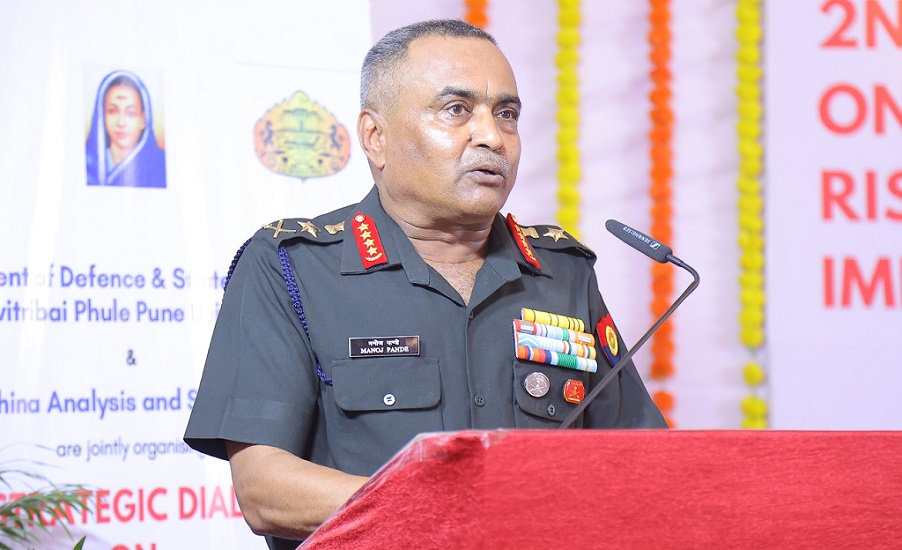China’s Rapid Military Rise And AI Focus Raises Global Concerns: Army Chief Manoj Pande

Pune, 27th March 2023: Army Chief Manoj Pande today delivered a talk on the theme of ‘Rise of China and its Implications for the World’ at Savitribai Phule Pune University.
Here is the text of his speech:
Firstly – on the overall Strategic Context in which China’s rise needs to be seen, Secondly – China’s Rise per se, followed by– the implications of China’s Rise on our Regional and Operational environment, and finally – how are we Addressing the Challenge.
· Let me begin with the overall Strategic Context.
· In today’s geo-economics continues as the lead driver of geo-political shifts. Complex global relationships are taking shape, driven by an interplay of Interests, Concerns and Aspirations. The resultant power plays range from cooperation to competition and containment to confrontational strategies. Consequently, strategic linkages are being redrawn as ‘Interest based Alliances’. Traditional Partnerships are under stress due to cost, duration and level of support. The bottom-line in all these parleys, reflect the primacy of one’s National Interests.
· The ongoing Russia-Ukraine conflict has only added to the turbulence in this landscape, with many aspects emerging profoundly in the geo-political security calculus.
· The relevance of Hard Power has been reaffirmed along with the primacy of land in determining ‘victory markers’ and the imperative to be prepared for the ‘long haul’.
· But for the nuclear domain, the sabre rattling of which did figure, the war has spanned the entire spectrum of conflict, with Grey Zone aggression factored in as an increasingly preferred strategy of conflict prosecution. This conflict has in fact been a watershed for Technology, which has emerged as the new strategic arena of geo-political competition.
· Concurrent developments in Disruptive and dual use technologies like quantum computing, generative AI, nano-technology, 3D printing, robotic exo-skeleton along with progression in kinetic instruments like hypersonic weapons, high power lasers, swarm drones, autonomous systems, manned-unmanned teams etc, are making the battle space more complex, contested and lethal.
· South Asia is one of the least economically integrated entities in the world, resulting in security and economic imbalances in the region. We may visualize our immediate strategic neighborhood as an ‘arc of uncertainty’. Unresolved border disputes, both territorial and maritime; illegal cross border migration, trans national crimes, non-traditional threats such as illegal and unregulated fishing, piracy and increasing religious fundamentalism, coupled with regional vulnerabilities to climate change induced disasters, are going to keep the South Asian region in a flux. These manifestations certainly have an impact on our national security.
· It is amidst this background, that China’s rise continues. It is driven by its regional and global aspirations, as also impacted by its internal dynamics. Let me briefly dwell on the relevant markers of the rise of China.
Rise of China
· China’s rise as a political, economic, technological and military power has accorded it a new hierarchical position in the world order, which it intends to lead.
Rise as a Political Power
· China’s strides as a political powerhouse are evident in its pursuits for a much larger and higher seat on the High Table. Brokering of Peace Talks between Saudi Arabia and Iran and putting forth the Chinese 12-point Peace Plan for ending the Russia-Ukraine conflict, is reflective of a Chinese urgency to replace US as the global Net Security Provider.
· It is also attempting to gain clout in international organisations which were traditionally dominated by Western nations. The means though remain through steady acquisitions of key official positions, use of economic leverages and aggressive ‘wolf warrior’ diplomacy or ‘bullying tactics’.
· China advocates its political system as a ‘Democracy that Works’, distinct from Western practices of democracy. It defines this as ‘social democracy’. The prosperity quotient of Chinese citizens, their higher requirements of material and cultural life and the economic heft of the nation today, are put forth as proof of efficiency of their ‘Model’.
· Its multipronged strategy entails on the one hand, support to international Institutions and Agreements that seem aligned to its goals and norms, yet on issues of divergence such as human rights, it seeks to undermine such values and create alternative Institutions and Models. In domains, where norms and institutions are still being established, such as internet governance, it works with like-minded regimes to create standards that reflect their interests.

Economic Rise
· Today it stands as the largest economy in Purchasing Power Parity terms. Its economic rise however, is also multifaceted. On the one hand, it is building an ‘international network of coercion through predatory economics’, while on the other it claims pulling out more than 100 million of its own people out of poverty. Its pursuit to expand the sphere of influence through economic manoeuvring, weaponization of resource supply chains, financing large infrastructure projects with scant regard for environmental and safety standards and straddling recipient countries with unsustainable debt, are there for the world to see.
· Issues of concerns also continue to exist in cases of theft of Intellectual Property Rights, stealing trade secrets and technology from foreign companies as also its unfair trade practices.
Technological Rise
· China’s technological pursuits have been characterized by systemic efforts to acquire technologies from the West. This also entailed aggressively luring or poaching scientists and researchers from the West, with unrestricted funding offers. Consequently, today China has established a vast lead in high-impact research across majority of emerging technology domains of defence, space, robotics, energy, biotechnology, artificial intelligence, advanced materials, hypersonic systems, 6G and quantum technology. For some of these domains, all of the world’s top 10 lead research institutions are based in China and are collectively generating more high-impact research papers than any other country. China today is the world leader in patent applications.
· The Chinese, by virtue of being a totalitarian State, have given shape to an institutionalised civil-military eco-system which aims to harness technology, knowledge, governance and infrastructure to security ends.
· With such tech-enhanced capabilities China can, and is accruing national security advantages for itself whilst posing a threat to its competitors and adversaries.
Rise as a Military Power
China’s economic transition and technological progression has given it the capability to emerge as a major military power. Concurrent to its military rise, its strategic doctrines too have seen various shades – from a War Zone Concept of fighting a limited war under high tech conditions to Three Warfares approach entailing public opinion, psychological warfare and legal warfare and off late to that of an Unrestricted Warfare, with conventional capacities being available to effect massive destruction of an adversary.
· The continued focus on technology and specifically AI into its military war fighting systems and doctrines is evident from the 19th Party Congress Report. It urged PLA to accelerate the development of military intelligentization entailing not only integrating AI into existing warfighting functions, but to use it to shape a new, cognitive domain and revolutionize their approach to warfighting. This was also reflected in its 2019 Defence Whitepaper which propagated ‘fighting and winning intelligentized wars’.
· In the response context, it is also prudent to recognise China’s Grey Zone actions, which involve kinetic and non-kinetic forms of assertiveness and coercion aimed at achieving strategic goals without provoking a conflict. Selective historical referencing, intelligent obfuscation of reality using legal frame work and exploiting technological prowess in cyber and information operations, are some of the common tools in the Chinese playbook.
· It is increasingly displaying a willingness to project its military power as seen from its aggressive attempts to establish military bases in the Indo-Pacific, Africa and more importantly in our immediate neighbourhood as well. The rapid expansion of PLA Navy is reflective of its extra-regional power projection intentions. The proliferation of its military weapons, equipment and technology is enhancing military capabilities of a number of States, some in South Asia too, which is of concern. Its forays in the South China Sea, rejection of International Tribunal awards on maritime claims, activities in the Taiwan Straits and actions along the LAC bordering on bellicosity – make it increasingly apparent that China’s interpretation of an ‘international rules based order’ rests on ‘might is right’.
China’s alignment with Global Pursuits
· The establishment of the multilateral financial institution – the Asian Infrastructure Investment Bank, which invests in infrastructure projects across Eurasia does follow international lending standards and often cooperates with the World Bank and the Asian Development Bank. On Climate Change norms, its stance has shifted from resisting international cooperation in the yesteryears to one of reducing usage of fossil fuels and becoming the world’s biggest investor in renewable energy.
· Having seen the key facets of China’s rise, I shall now focus on the Regional Geo-Strategic context and Operational Environment as relevant to us.
· In the Indo-Pacific, a shift of global power play is distinctly discernible, in the recent years. Geo-political relevance and geo-economic weight of the Indo-Pacific nations have only augmented the geographic indispensability of this region to world maritime trade, and that of China in particular.
· China’s assertion in this region has been reflected most profoundly in its claims on disputed islands in the South China Sea, followed by unilateral actions to build military facilities. The significance it attaches to these occupations is reflected in their definition of the same as ‘core interest’ and ‘non-negotiable’.
· China’s resolve for reunification of Taiwan, was reflected once again in the White Paper published post Nancy Pelosi’s 2022 visit to Taiwan, which reiterates China’s stance as, ‘a shared aspiration of all the sons and daughters of the Chinese nation’, and ‘an historic mission of the Chinese Communist Party’.
· China’s engagement with ASEAN has largely focused on economic development and domains of non-traditional security. It also seeks to create an alternative architecture of Rules and Institutions, on the basis of ‘shared beliefs and norms’, that can be identified as a ‘community of shared destiny’.
· India’s strategic location astride the vital Sea Lanes of Communication, propels us as a key player in the Indo-Pacific contestations. In contrast to Chinese strategy unfolding in the Indo-Pacific, our strategy has been defined in our vision for the Indo-Pacific, as Security and Growth for All in the Region (SAGAR), the essence of which can be found in the words of our Hon’ble Prime Minister, who said and I quote, ‘When the oceans are open, the seas are secure, countries are connected, the rule of law prevails and the region is stable, nations, small and large, prosper as sovereign countries’, unquote.
· I would like to make a mention of the ‘strategic architectures’ taking shape in the Indo-Pacific. The evolution of QUAD is testimony to increased opportunities, responsibilities as well as challenges for us in these expanded strategic horizons, in future.
· China’s views on the QUAD are complex, reflecting its broader concerns about the balance of power in the Indo-Pacific region. China has criticized the QUAD as a Cold War relic and accused member countries of pursuing a ‘security alliance’ to undermine China’s interests. Concurrently, China has also downplayed the significance of the QUAD, describing it as an ‘artificial’ grouping that lacks coherence and is unlikely to have a lasting impact on the region.
· While QUAD linkages will get augmented in the years ahead, yet ‘core interests’ of individual nations will reign supreme over providing active military support to us in case of a conflict with our adversary. This necessitates the need for India to be self-reliant in her needs to protect National Interests.
The South Asian Region, in particular
· In South Asia, amongst the ‘developing countries’, we have those with counter pressures between political aspirations, domestic needs and economic capacity. These often have fallen prey to Chinese economic traps. Examples in our neighbourhood are there for us to see. The lead example has been the flagship corridor of BRI – the CPEC which continues to be mired in issues of lack of transparency, accountability, security, and ability or inability of Pakistan to pay off the loans.
· In addition to Pakistan, it is also leveraging its politico-economic heft on Nepal, Bhutan, Myanmar, Sri Lanka, Maldives and Bangladesh, to accrue increased influence quotient for itself in the South Asian geo-strategic canvas. Chinese attempts to establish military footprints across South Asia, are common knowledge now. Of late, its power projection into the Indian Ocean has only increased with enhanced forays by the PLA Navy.
· In essence, China’s geo-political and geo-strategic design in this region can be termed to entail shaping perspectives through coercion, in its belief that ‘tributary States need to observe hierarchy’.
Implications for the World
· From the issues that I have spoken thus far, certain key aspects emerge as implications for the world.
· Firstly, China intends to challenge the world order led by the U.S. and aims to emerge as the leading superpower.
· Secondly, with the economic heft and the supply chain dependencies and leverages it has accrued for itself, it is capable of unfolding a ‘brute force economic policy’, making geo-political and trade engagements into zero-sum games.
· In the Political domain, the steady creep to hold the leadership positions in top international institutions and its displayed stance as a member of the UN Security Council, reflect an intent to control world policies. In some cases, parallel organisations too are being formed congruent to China’s requirements and geo-economic strategies. It also suggests increased cogency between China’s foreign policy and military prowess, in the prosecution of China’s aggregate national interests.
· As a leader in niche Technology Research and Development, it has accrued for itself the capabilities to retain a dominating and dictating position in myriad of domains, where technology is an enabler.
· Next is the increasing belligerence stemming out of both economic and military power. Increasingly evident attempts by China and propensity to project power outside its region, portends a threat to ‘rules based international order’.
· Leveraging of its military power to settle disputes, regain territories to which it stakes claim and establish new footprints to safeguard its interests, has serious implications in the global security canvas.
· Last but not the least, with the Comprehensive National Power it has secured for itself, it is certainly in a position to establish strategic partnerships, dictate regional geo-political developments, shape major world event outcomes by weaponization of instruments, linkages, dependencies and conditional support.
Operational Environment
· The most important aspect of our Operational Environment remains our legacy challenges of unsettled and disputed borders. Pockets of dispute and contested claims to territory continue to exist due to differing perceptions on the alignment of the LAC. Transgressions remain a potential trigger for escalation. Border management hence requires close monitoring, as infirmities in border management can lead to wider conflict.
· We have four Agreements and Protocols of 1993, 1996, 2005 and 2013, in the military domain to maintain peace and tranquillity on the LAC. Of concern, remains the violation of these by China with their attempts to carry out transgression across the LAC. The boundary issue cannot be divorced from bilateral relations. This is amply reflected in the statement by our External Affairs Minister, Dr S Jaishankar, who said and I quote, ‘For ties to return to a positive trajectory and remain sustainable, they must be based on the three mutual; mutual sensitivity, mutual respect and mutual interest, and I reiterate that the state of the border will determine the state of the relationship’, unquote.
· The current engagement mechanisms exist at the Political, Diplomatic and Military levels, which are being optimally utilized to ensure stability along the LAC. Talks are continuing, under these established mechanisms.
· China has over the years accrued significant capacities for force mobilization, application and sustenance of military operations, consequent to development of infrastructure of military significance, be it roads, airfields, helipads and billeting structures.
· The Indian Army’s strategic orientation and long term capability development has been with a focus on the Northern borders. We have carried out the required re-balancing of forces to effect the desired response metric on the Northern borders. We have adequate reserves and are prepared for any contingency.
· Our preparedness remains of a high order and troops continue to deal with the PLA in a firm, resolute and measured manner, while ensuring the sanctity of our claims.We have ramped up our efforts to fructify the operationally critical infrastructure and logistic requirements – especially the forward area roads, Helipads and billeting for our troops. The Indian Army is working in synergy with all agencies to upgrade the infrastructure.
Prognosis
· If one was to give a Prognosis on the subject from India – China perspective, certain key issues come to fore.
· India has today emerged as a significant player in the global stage. Today, we are the voice of the Global South, with our growing economy, technological advancements and strategic partnerships with other nations. Our soft power, cultural diversity and democratic values also contribute to our rising influence on the world stage. As former U.S. President Barack Obama once said, and I quote, ‘India will play a defining role in the 21st Century, as a responsible global power’, unquote. That statement acknowledges India’s potential as a leading nation in the world and its ability to shape the course of global affairs and is a testament to its resilience, innovation and commitment to progress.
· India – China bilateral ties, do stand influenced by the great power rivalry currently playing out between China and the U.S. The Chinese strategic community and leadership view India’s relations with the U.S. as aimed at balancing China. Former Foreign Secretary Vijay Gokhale, notes in his Paper that, ‘the correlation between the growing strategic relationship between Delhi and Washington and the deteriorating ties between Delhi and Beijing seem to bear out the basic premise – that China sees India mostly through the lens of China’s relationships with the United States, Russia and other Powers’.
· Major powers today appear ready to take the China issue head-on. The US-China contestation is sharpening by the day, and Europe too, is re-evaluating its ties with China. Western powers are claiming bigger stakes in the Indo-Pacific and partnering with states in the region to provide an alternative to Chinese hegemony.
· 2023 in fact will be a watershed year for India in global policy making. With the presidency of G20, India shall play an important role in finding pragmatic global solutions for the wellbeing of all, and in doing so, manifest the true spirit of ‘Vasudhaiva Kutumbakam’ or ‘World is One Family’. The SCO presidency provides us an opportunity to further strengthen our ties with Russia and the Central Asian Republics, to accrue the required counterbalances in the security canvas.
· The relations between the two countries essentially need to hinge on the principle of mutuality. To ensure peace along the LAC, adherence to existing protocols and agreements are a sine-que-non. LAC needs to be respected and disputes should be resolved through established mechanisms and not through unilateral application of force by troops on ground to alter status quo.
· Maintaining peace and tranquillity on the borders forms the very basis of development of relations in other fields.The situation along the LAC needs to return to normal and status-quo must be restored, before the bilateral relations can move forward. The words of our External Affairs Minister, Dr S Jaishankar, make this amply clear and I quote, ‘India’s relationship with China is challenging and abnormal; You cannot violate agreements and pretend everything is normal’, unquote.
· Both sides need to be sensitive to the aspirations and interests of the other side as the second and fifth largest economies of the world. As we seek to narrow our divergences and manage our differences, understanding the long term perspective, is very essential.
· If one were to dwell specifically on China’s rise and predictions that it would soon effect a unipolar world, I would like to quote our External Affairs Minister Dr S Jaishankar, who said, and I quote, ‘The rise of China, the share of China in global economy, in global technology, in global influence, these are undeniable factors. But the fact is that, in this decade, you are clearly going to see many more powers, who will have more influence on global debates and global outcomes than they did before. Some of them would be sufficiently separated from the rest of the herd to be seen as a pole, and therefore you will have multipolarity’, unquote.
Finally coming to how are we Addressing the Preparedness Imperatives
· Speaking specifically about the Indian Army, I would like to highlight the steps taken by us to address the imperatives, in light of the security implications I have covered in my talk thus far.
· We intend to enhance our operational preparedness and increase efficiency in functional & administrative domains, towards becoming a modern, agile, adaptive and technology enabled future ready force.
· Our Road Map to achieve this entails undertaking a Transformation, that stands on the edifice of five pillars, that is – Force Structuring & Optimization, Modernization & Technology Infusion, Systems Processes & Functions, Human Resource Management and Jointness & Integration.
· As part of Force Structuring & Optimisation endeavour, our intent is to reshape our organizational structures from the perspective of future needs for achieving a better combat response metric. We are making a transition from a ‘manpower intensive’ Army to a ‘technology driven’ Army.
· Under the Modernization & Technology Infusion endeavour, major initiatives are underway to transform ourselves into a modern, technology driven, Atmanirbhar and battle worthy force, so that we can execute our operational mandate, more effectively. Provisioning modern weapons and equipment and leveraging niche technologies, is intrinsic to this effort, for which the Indian Army is committed to find indigenous solutions.
· The next transformational pillar, entails efforts to enhance the efficiency of our Systems, Processes & Functions, Technology is being leveraged to augment effectiveness and outcomes through Automation, Digitization and Networking.
· In the Human Resource Management domain, a path breaking and progressive initiative has been taken, through the implementation of the Agnipath Scheme, which is progressing well.
· As part of our fifth Pillar of Transformation, our pursuit to Jointness & Integration with the other Services remains an enduring one. The cross-linkages are being nurtured so as to aggregate our capacities and capabilities.
Join Punekar News Whatsapp Group, Telegram, Instagram And Twitter For Regular Update about Pune City And Pimpri-Chinchwad





